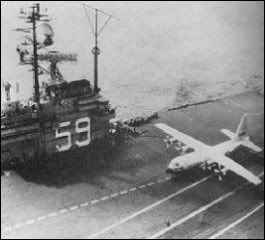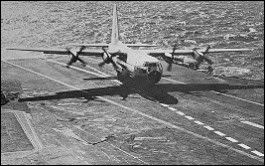youngflyer
Well-Known Member
When I was flying some patterns at KSYR, the controllers was using an odd phrase when clearing the f16s for landing. He stated "Cobra XXX, the cable is now up". What does this mean?
They don't have thrust reversers either, so those tiny brakes are their sole means of slowing down. And sometimes, that's not enough--which is where the cable comes into play. The pilot simply drops a tailhook like those on Navy aircraft--only not quite as beefy, since it's rarely used. Hook catches cable, airplane comes to a stop.
It's not an ordinary event to take the cable in a USAF fighter. It's either an emergency or a boffed landing that causes you to do that.
You still gotta practice doing it though, right?
No. I've never practiced a cable engagement.
It's actually a fairly dangerous maneuver for the jet and time/effort consuming for the airfield which the barrier is on.
When my dad was in the AF back in the 50's, he was part of an experiment to operate AF planes off of carriers. They took some F-100s and rigged a hook on them. His flight was able to trap aboard the boat, but the contraption which was rigged to attach the nose gear to the catapult was so shady that the AF pilots refused to take off because they felt the nose would be ripped off the airplane. Eventually some Navy pilots flew the planes back.
When my dad was in the AF back in the 50's, he was part of an experiment to operate AF planes off of carriers. They took some F-100s and rigged a hook on them. His flight was able to trap aboard the boat, but the contraption which was rigged to attach the nose gear to the catapult was so shady that the AF pilots refused to take off because they felt the nose would be ripped off the airplane. Eventually some Navy pilots flew the planes back.
The only cases of USAF airplanes I've ever heard of on a carrier was the U-2. They were craned onboard, and took off for some special mission over China.
Very few (if any) USAF aircraft could take the impact of traping onboard the boat without a complete redesign. Some Navy airplanes were launched by a "bridel" instead of the nosewheel. Theoretically this could be done, but it's just not praticall.



The Navy bought some F-16s for adversary training, and they wore them out in a remarkablly short time.
The Navy bought some F-16s for adversary training, and they wore them out in a remarkablly short time.
The U.S. Navy has grounded eight of its General Dynamics F-16N fighters due to structural cracking in the center fuselage area.
Cracks have been found in the F-16N's center fuselage carry-through bulkhead at fuselage station (FS) 341 and in the "fuel shelf" between the upper and lower bulkhead structures at FS 325, 341 and 357. The aircraft have two to six cracks with lengths less than 0.030 inches.
Several U.S. Air Force F-16s - including those flown by the Thunderbirds demonstration team - have experienced upper skin cracking around access panel cutouts.
No other F-16 users have grounded their aircraft for safety reasons related to cracking. There also have been no flight limits placed on F-16A/B models, including the Thunderbirds.
A philosophy difference between Navy and Air Force design criteria explains why the Navy's F-16Ns are grounded, while USAF F-16s continue to fly with similar structural cracking. Although the fighter was designed to Air Force "durability criteria", the Navy is maintaining its F-16Ns according to a fatigue-based concept that automatically grounds an aircraft if structural cracking is detected.
The only cases of USAF airplanes I've ever heard of on a carrier was the U-2. They were craned onboard, and took off for some special mission over China.
Well, here's another USAF aircraft on a carrier:

The C-130 wasn't taking traps or cat shots but the pilot wento into reverse while airborne to land. Peformed a deck launch for takeoff.
Abtually that was a Navy C-130 flown by Navy test pilots.
The "Supper COD" program was an experiment that worked fine, but had several "real world" drawbacks. Mainly the fact that if the C-130 ever broke onboard, it would foul the entire deck. The only solution would be to push it over the side.
The only cases of USAF airplanes I've ever heard of on a carrier was the U-2. They were craned onboard, and took off for some special mission over China.
I know what the test program was about. I'm pretty familiar with carrier operation, having flown COD's for 8+ years. I posted the pics due to your previous comment.
